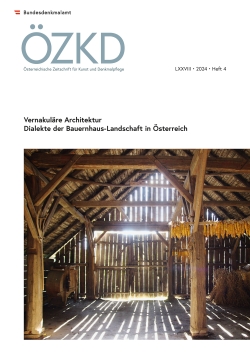
ÖZKD LXXVIII 2024 Heft 4, pp. 49-58, 2025/02/12
Vernakuläre Architektur
Dialekte der Bauernhaus-Landschaft in Österreich

In Styria, researching farmhouses has a tradition going back to the 19th century. This research was institutionalized through the initiatives of Archduke Johann, which led to the founding of the oldest institute for folklore studies in the German-speaking world through Viktor von Geramb at the University of Graz. Although vernacular architecture dwindled during the 20th century, it became documented and presented in museums. This laid the technical foundation for the Austrian Open Air Museum Stübing, founded in 1962 according to Scandinavian and Swiss models. In addition to multiple initiatives to preserve Styrian farmhouses by offices of the province of Styria in recent decades and the establishment of the Styrian Revitalization Fund, the Austrian Federal Monuments Office has striven to preserve Austria’s diverse rural heritage. This has proved challenging due to societal changes that are still taking place.